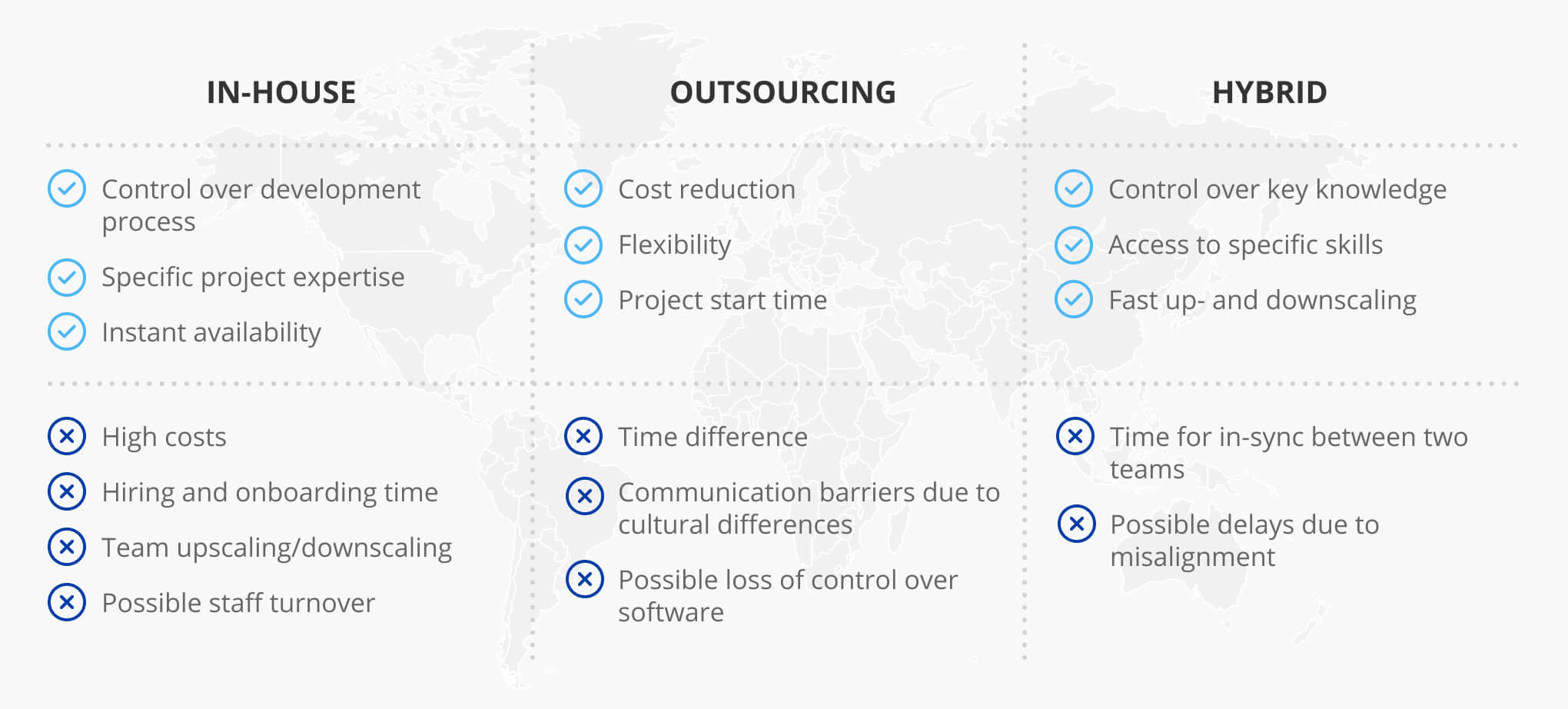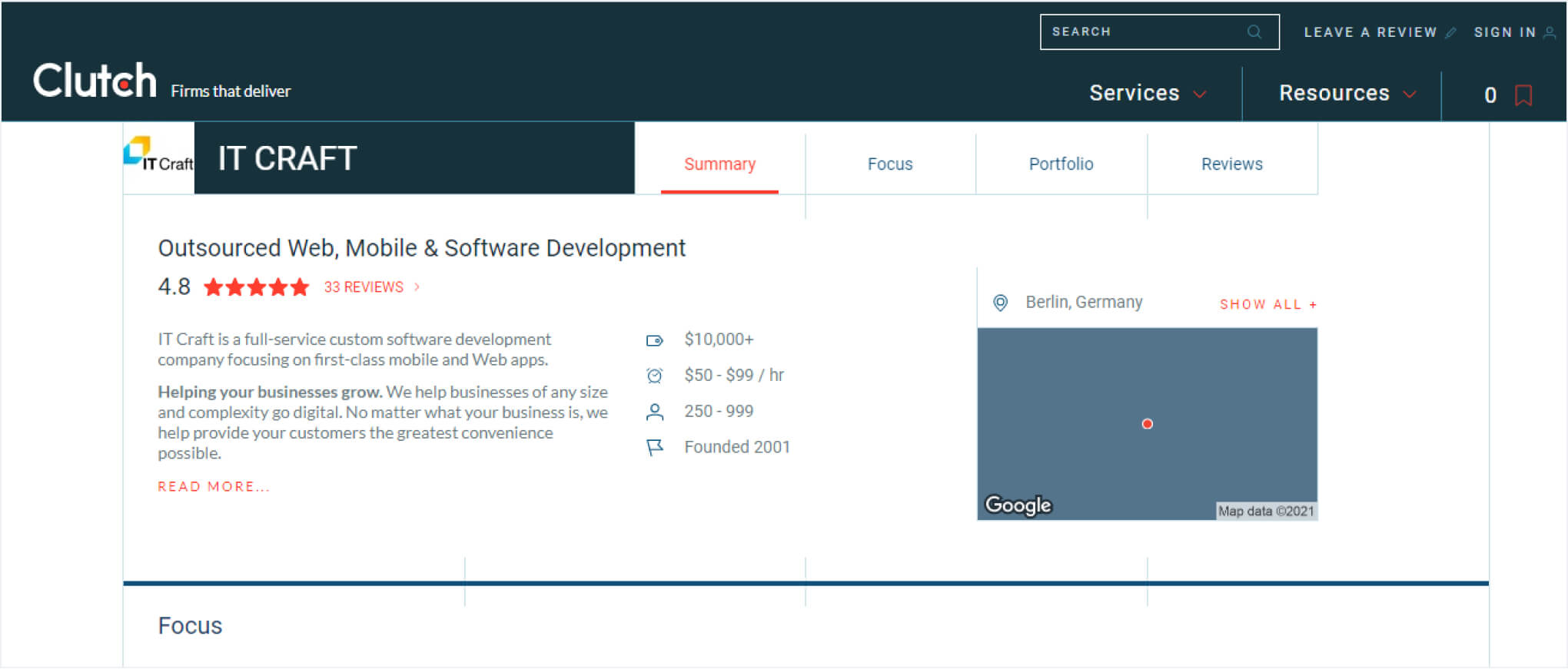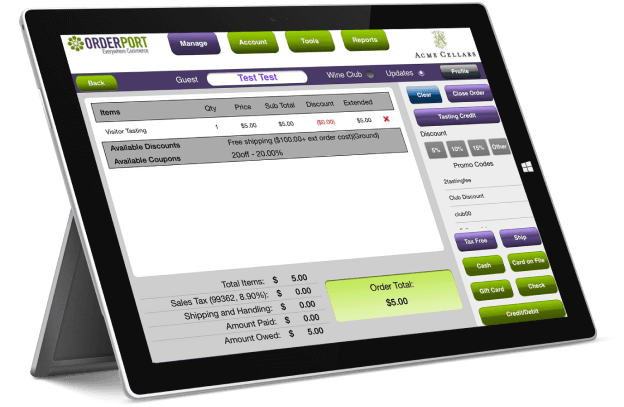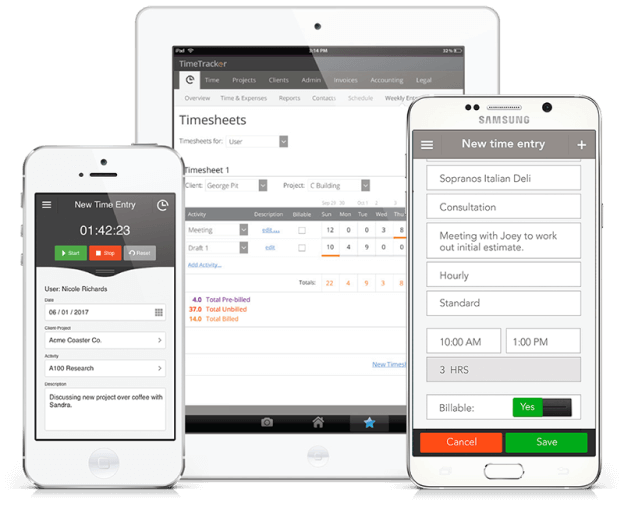All businesses planning to outsource app development need to consider different options to pave the best path to their goal. As a product owner, you need to ask
relevant questions. The more precise the questions, the more precise the answers
you get and the greater your chances to launch your app on time and on budget.
Most risks can be eliminated before development starts.
This post analyses how to outsource app development and achieve a win-win
working relationship.
Escape most common mobile app
development pitfalls. Use the points
below to
figure out realistic answers about mobile development outsourcing.
Why (and when) to opt for outsourcing app development
When a company plans outsourcing app development, it is crucial to articulate
expectations. What are yours? Do you want to cut long-term costs? Add missing
expertise in a specified area? Expand rapidly to a new platform?
As a product owner, when you plan carefully, your chances of finding the best
team increase greatly.
It is equally important to figure out the beginning and end points of
application outsourcing (launch? app updates? migration?).
The following questions are essential because they directly affect
outsourcing
app development scope and timeline:
- Are you starting from scratch or expanding an existing software solution?
- Are you integrating it with your company’s existing solutions?
- Will your app use smartphone hardware (accelerometer, Bluetooth, etc.)?
- Do you already have some source code? Do you want to use it?
- Are there any industry-specific regulations the development team must keep
in mind? - How many users do you expect?
- Do you want an app for internal use? Or do you plan to sell it?
- Do you want to hire an outsourcing development team to complete app
development? - Do you also want ongoing maintenance?
Some answers might reveal obscure but essential information for the future
development team.
At the initial stage, the product owner needs to determine the right
strategy.
He needs to consult a person with a strong technical background.
Two examples:
-
Example 1
A company has a Web app and an Android app. They now need
a team to develop an iOS app. When building an iOS app, the development
team must keep the architecture of existing apps in mind. They should
avoid starting from scratch and designing their own. They must remember
app synchronization and other important features. -
Example 2
Initially, a company needs to decide whether they plan on
developing an internal app or an app for sale. The apps have different
app architecture. A sudden pivot in the middle of the development
process means major code base redevelopment. Avoid this costly and
avoidable work on the project.
Choosing among many outsourcing app development options
The market of application development outsourcing encompasses the entire world.
There is a variety of offers in the market. Companies have flexible terms of
pricing, technologies, and cooperation models. You can choose a cooperation
model
best suited to project needs.
The choice of outsourcing app model depends on:
- desired budget
- planned timeline
-
scope of work
– app only development
– app development and maintenance
– app development, maintenance, and regular updates
- number of required features
- amount of time product owner can spend on team management
- team’s expertise in specific business domain and knowledge of specific
regulations
in this domain - readiness to take on a partial project and coordinate efforts with another
team (if
needed)
Make a list of priorities. Think what fits in with your priorities.
In-house development vs. mobile development outsourcing
The first thing that comes to every project owner’s mind is choosing between
the in-house team or application development outsourcing. Both can be great when
specifics and limitations are understood.
With an in-house team, you build the processes and adjust them flexibly. An
in-house team is available within the same business hours. Business keeps
critical
project knowledge internally. Fewer people have access to sensitive information.
On the downside, an in-house team is expensive. Apart from high salaries and
benefits, it takes a lot of time to find, hire, and retain a missing specialist
in
this overheated market. Business needs to keep an HR department, think about
perks
and bonuses for its employees, safety measures, and more.
In its turn, an outsourcing team is a faster and cheaper option. As a
business, you
do not pay for recruitment and onboarding. Also, a team from a cost-effective
region
can be 2 – 3 times cheaper due to lower hourly rates. Usually, a team can start
a
project fast. No need to wait until vacant positions are filled. Team size can
vary
based on your needs: fast upscale, fast downscale.
However, outsourcing, too, has its downside. You will need to spend time on
communication and alignment. Expect delays if the team is located in a distant
region and the overlap in business hours is short. Clarifications and approvals
might take more time than expected.
You can get the best from both approaches by mixing them. Try team
augmentation.
Team
augmentation means you can have two or more teams
simultaneously working
on
your project. One team focuses solely on its part of the work (e.g., outsourcing
app
development) and coordinates its activities with another team (e.g., with the
other
team focusing on API development.)
A hybrid team takes the best from both application development outsourcing
and
in-house development. You retain control over your software. You can upscale and
downscale fast and for reasonable costs.

Team engagement
When you outsource app development, you can choose the cooperation model that
fits
in with your further plans.
Do you have no IT department right now but are working on establishing one?
Or do
you plan to continue mobile app development outsourcing?
Based on scope of post-launch activities, there are two main outsourcing app
development models:
Delivery team – team launches the app and
switches to the next project.
Dedicated team – team continues working on app
maintenance
and updates after
launch.
Focus
Technological stack and focus
usually depend on company details,
including:
- general development companies
- companies specializing in a specific industry (e.g., telemedicine
app
development) - companies with specialization in a certain technological domain (e.g.,
Virtual
Reality, data mining)
General development companies have broad experience and low hourly rates.
Specialized companies have specific experience and higher rates (and
accomplish
certain tasks more quickly). It makes sense to consider companies of both
types
depending on your requirements.
Here are the best scenarios for your project:
-
The company has launched a similar project
recently. They know
how to handle your project and can provide you with a precise
roadmap. -
The company has experience in your industry
– They need less time to get specifics of your business and correct
their plan as soon as they dive deeply into details. -
The company has worked on a variety of
projects and can provide you with a relevant project map. The
company might lack narrowly focused expertise but they are flexible
and can learn fast.
Pricing
Pricing directly affects the budget. A company’s hourly rate depends mostly on
its
location. Prices increase from East to West. Eastern-Asian companies are
cheapest;
US/Australian companies are most expensive.
Whatever destination you choose, you can negotiate on one of two main pricing
models:
- Fixed price
– You agree upfront on project costs. Projects
with clearly defined
scope are better-suited for this. - Time and
materials – You pay based on how much time the team
spends on your project.
This works for projects with flexible requirements.
For example, you plan to create a
fitness app from scratch. You do
not
have an
in-house team. You have assumptions and might need to change requirements based
on
user requests. You will also need someone to make updates.
Your clear choice is completely outsourcing to a dedicated team. It is best to
choose the time and materials pricing model.
Can both approaches be mixed? Yes, as long as you keep balance between costs and
flexibility. If you do not want to keep up with costs and stay flexible, set up
a
monthly budget and ask the team to notify you in advance when they are likely to
exceed it. Any changes done are based on how much monthly budget remains.
Cost to outsource app development at a company
Costs of mobile development outsourcing for an app of average complexity could
vary between $16,000 to $80,000. Costs could easily skyrocket to $150,000 to
$200,000 for complex apps.
To help you see the big picture, let’s consider several app types. Below are
costs needed to develop a “typical” app:
Also add app maintenance. Its cost equals 15% – 20% from initial costs per year.
For example, if making a
social media app costs you between
$48,000 and
$120,000, maintenance will cost you between $7,200 and $24,000 per year.
Steps to outsource app development to the right team
When you have a list of requirements and have outlined specifics of the project,
it is much simpler to find the right team for mobile app development
outsourcing.
You can divide the entire process of finding a team into six steps:
-
stepSearch for professionals
Use Google search. You can also consult online field guides such as
Clutch,
the standard for “data-driven field guides for
B2B buying and
hiring decisions”. Set up search parameters based on your preferences
(location, hourly rate, average review rate, etc.). Read reviews about
company projects. This gives you a bigger picture on mobile app
development outsourcing provided by companies. -
stepList your top 10
Select the companies that best suit your criteria. When you have a list,
it is easier to do a thorough evaluation. Go through each company
profile. Visit each website and learn more about them. Find out what
businesses outsource app development projects to each company. If there
are similar projects in the portfolio, the company could probably handle
yours. -
stepShortlist five
Now reduce the list to five. These are your candidates. You are going to
outsource mobile app development to one of these companies. Your next
step is to communicate with each of them personally and learn more about
the companies and people who work there. Send your requirements and
request a call with a project manager. -
stepHold interviews
Prepare a list of questions. Ensure the list and format are the same for
all companies. You need to have the same format and questions to help
your decision-making process. Set up a call with each company. Discuss
project details. Listen to the company’s suggestions on project
implementation. Ask questions and observe the company representative’s
reaction to them. -
stepRank companies
After you have met with the companies, give them points from 1 – 5 for
each criteria that matters to you (price, response time, level of
interest, competence level, etc.). Give each interviewed company points
for every category indicating both strong and weak sides. -
stepSelect the best provider
Now you have your top choice that suits your project requirements. You
can start refining estimates and discuss details on cooperation.
What if your top choice cannot start the project when you want to start?
Where can you find a company for application development
outsourcing?
The first step is crucial: finding and booking a reliable development team.
Try searching through the following platforms:
-
Clutch
Again, Clutch is a great
information
resource. You can
segment search
results based on multiple criteria. Get comprehensive information about
a company from its profile, go to its website, or get in touch
immediately.For example, this is what IT Craft’s profile looks like:

Still, the biggest platform value is verified reviews. Company managers
conduct interviews with software development company clients ensuring
trusted, accurate information is published.Companies receive badges and rankings based on their performance in the
system. Try different sorting criteria to refine your list. -
Goodfirms
This company is similar to Clutch. It also provides various rankings and
does a comprehensive search through the platform. When accessing a
certain category, users can look through the overview ranking or switch
to the research section which is more illustrative.Goodfirms
provides more options.
Apart from written
interviews, video
reviews are available. Users benefit from buyer’s guides.Still, Clutch’s evaluation system seems to be more encompassing and
transparent. -
Upwork
This is a renown platform for freelancers.
You can hire almost any specialization here from all over the world.Use job success rating to select top performers. Owners of “Top
Rated”
badges care about their reputation to keep receiving contracts. You
ensure professionals provide you with results on time.Companies are also present on Upwork that has their own profiles.
This
is why Upwork can
be a place where
you find a provider
for reasonable
costs.
Checking a company’s services and expertise
When you decide to outsource mobile app development, also check all the company
websites.
-
Go through the services section.
See what service range a company can offer to you (e.g., in on-demand
app
development).A great company can pick up your project right at the point you need
them.
It can:- translate a business idea into technical requirements
- design a realistic roadmap
- prepare app design and source code
- extend your presence on platforms
- help you reach missing deadline
- optimize app infrastructure
…and more.
Make sure it provides services you need.
-
Look at the company’s portfolio.
A company’s list of accomplished projects speaks best about its level.
See what software solutions make the company feel proud. Go through
challenges and wins on projects.For example, IT Craft has handled projects of different complexity,
different life-cycle stages.Here are two projects for illustration.
-

OrderPort
Native
iOS appOrderPort is a mobile Point-of-Sale
(POS) for wine businesses. This
app makes it easy to manage
different types of wine sales. It also supports
inventory
tracking, analytics on sales rates, and
more.
The client wanted an iPad app. He had source code for part
of the app. The IT Craft team started with an in-depth code
review to ensure it could handle requirements. The team
fixed errors and worked on preparing a detailed project
specification for missing functionality. Then the
development stage started. The app was launched and the team
continued working on its updates and optimization.OrderPort is a mobile Point-of-Sale (POS)
for wine businesses.
The client had source code for part of the app. The IT Craft
team started with an in-depth code review. The team fixed
errors and worked on preparing a detailed project
specification for missing functionality. Then the
development stage started. The app was launched and the team
continued working on its updates and optimization. -

eBillity
Native iOS appeBillity apps make it possible to
manage and approve employee’s timesheets. Employees can
enter the time they spend on a task from any place, any
device. eBillity app transfers information automatically to
accounting or payroll software.
The client already had a Web app, an Android app, and an API
developed by another team. He needed to expand to the iOS
platform. IT Craft’s task was to build a native iOS app
using the client’s UI design and ensure the app synchronized
smoothly with other parts of the system. After the iOS app
was launched, the team eliminated bugs in the Android app
and API helping improve the entire system.eBillity apps make it possible to manage
and approve employee’s timesheets transfering information
automatically to accounting or payroll software.
The client already had a Web app, an Android app, and an API
developed by another team. He needed to expand to the iOS
platform. IT Craft built a native iOS app using the client’s
UI design. After the iOS app was launched, the team
eliminated bugs in the Android app and API helping improve
the entire system.
-
-
Check testimonials.
Satisfied clients are willing to leave their feedback sharing their
cooperation experience.For example, this is what Martin Berg thinks about working with IT
Craft’s cross-platform development team:
Risks when you outsource mobile app development
Reality can be stressful. Especially, when it becomes distant from the imagined best-case scenario of app development for startups.
Unfortunately, risks are a part of any business activity. You can bump into them
when you outsource mobile app development.
Consider the following risks when preparing your plan. Discuss risks with the
team to test their reaction and the solutions they offer.
- Delivery delaysThere are three possible sources of delayed delivery: inaccurate
estimates, sudden changes of scope, and long approval times.Even the best development team might occasionally provide a wrong
estimate. Still, a good, dependable team will also provide an
explanation and a plan B.Regular deadline violations are a sign of a team’s incompetence. When
interviewing a team, ask them about their routine in case of discovering
the wrong estimate.Also, appoint a product owner—a person who responds quickly to team
requests to ensure the team does not stay idle.Or you could be that person. - Higher costs than expectedYou can expect costs fluctuations in case of flexible requirements or
change of scope throughout project completion. Developers might spend
more time than anticipated but provide improved source code.However, huge cultural differences must be factored e.g., in attitude
towards deadlines, transparency, or promises.Insincere companies might include hidden costs to the contract terms.Rule of thumb: avoid the team with the cheapest estimate, who
promises
to deliver everything but struggles to show how they will keep their
promises. - Irrelevant technologyChoosing the technological stack can be tricky. On one hand, the team can
be experts in a certain technology providing a solution faster and for
less. You launch software on time now. On the other, app updates and
maintenance become clumsy costing you money in the future.For instance, we have completely redeveloped hybrid apps using native
approach.The only advice here: share the bigger picture with your team where
your
solution will be in 3 – 5 years. They may offer a more expensive but
also a more sustainable path. - Inappropriate management / pricing
modelA fixed-price contract makes it clear how much you pay when you outsource
mobile app development. However, it works best on simple projects with
clear scope. If you want changes, this will change the scope. The team
will adapt and draw up an extra agreement extending timeline and
increasing development costs.Prepare for flexible budgeting with time and material. In return, you
can introduce changes to app requirements. But time and material may be
redundant for simple projects where no increased scope is expected. - Vendor dependencyOnce a business has little knowledge about how its software works, the
development team who knows project details could well become
irreplaceable. They might lose motivation for technical excellence and
lower the quality of their deliveries.Make sure you retain ownership over your system. Look for a team who
provides you with a guarantee period, well-commented source code, and
comprehensive project documentation.
How to outsource mobile app development: dos and don’ts
Outsourcing means less control over a team’s activities. This can be
uncomfortable.
Transparency is crucial. Regular, two-sided communication is the key to success.
It helps outsource mobile app development with minimum risks.
Below is advice on building workflow.
DOS
- Always start small – Provide the team with
a small pilot project and
see how they manage it. This can be Software Requirements
Specification (SRS), code inspection, or launching a minor feature.
The goal is to test drive the team’s skills. - Maintain transparency – Ensure the team
speaks openly on project
issues. Issues can happen during an outsourcing app development
project at any time. If the mobile app development team is not
afraid to immediately log issues, solutions are done at the lowest
possible cost. A cultural discrepancy can magnify issues. Ensure you
are on the same page as your chosen team regarding transparency. - Share essential information – When working
on a project, the
development team must keep end users in mind—their preferences, and
their habits. This increases the likelihood of designing an app
users want and need. - Ensure knowledge transfer – Besides
well-commented code, the team
usually prepares project documentation and a wiki. This way, every
new developer or new team can start working with minimal
preparation.
Don’ts:
- DO NOT leave the team
without a
product owner – Every project needs
a person who can make a timely, final decision on an issue. If not,
app development loses its momentum. The risk of missed deadlines
becomes reality. - DO NOT force the team
to finish a Sprint scope at any cost – unless
this is critical for survival of the business. When part of the
functionality cannot be completed within a given timeline, it makes
sense to extend its development time. The result of not following
this rule will be technical debt and a crashing app (= high
redevelopment costs.) - DO NOT ask for
requirement changes on a fixed-price project – New
requirements take more time. If you try to include a new scope into
an existing agreement, the team will try to reach it within the same
timeline. As a result, compromises are made. You might end up with a
disappointing result. Hence, new requirements are only possible with
a separate agreement and a separate estimate. - DO NOT make a serious
mistake by not allocating time/money for code
refactoring – Every app accumulates technical debt with time.
Programmers need time to improve any source code they develop. When
no time is allocated for this, app maintenance might become
challenging.
When outsourcing app development, the fewer unknowns, the greater the
possibility for on time and on budget delivery.
Follow these DOs and DON’Ts.
Effective mobile app development outsourcing: A summary
Your success depends on choosing a team that meets your expectations. Think in
advance what is and what is not important for you.
Choose a company most comfortable to you based on pricing or cultural
similarity. By the way, Eastern Europe maintains a pleasant balance between
development costs and cultural similarity.
Make sure you go along this five-step path to outsourcing app development:
-
Determine aims and specifics of the future app
development project. -
Make it clear about the scope of work. Ask for help if
you are not sure. -
Find a team capable of providing you with these options.
-
Take an active part in the development process or assign
a product owner to the project. -
Ensure developers have time to improve code base and
write documentation.
Thoroughly check a company’s background. Test a company’s skills with a pilot
task
before starting a big project.
Wishing you a successful launch!